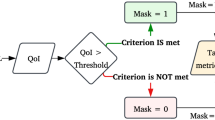Abstract
The recently developed flame particle tracking (FPT) technique [18] has provided critical insights into turbulence–flame interactions from the viewpoint of an observer co-moving with the flame. So far, FPT was implemented and used as a post-processing tool which required saving the Eulerian fields of fluid velocity and other scalars, obtained from the direct numerical simulations (DNS), onto external storage media. The field data were stored at equal time intervals which were usually smaller than the Kolmogorov time scale to accurately track the trajectories of the flame particles. The FPT, therefore, became extremely demanding on the storage space requirements, especially with increase in the domain size and/or the turbulence Reynolds number. Thus, there is a considerable advantage in terms of data storage, without compromising the accuracy of particle tracking, by implementing the algorithm to track flame particles within the DNS solver. We refer to this implementation as “on-the-fly” FPT as the particle tracking is performed concomitantly with the DNS. In this paper, we report the details of the first implementation of on-the-fly FPT in an open-source reacting flow DNS solver—the Pencil Code. The results from on-the-fly FPT are validated by analyzing the time series of the scalar property which by definition is required to be conserved along the trajectories of the flame particles. Subsequently, we use on-the-fly FPT to investigate the dynamics of flame annihilation. As the flame surfaces interact with turbulence, the flame particles defined on them preferentially drift and cluster in the trailing, concave regions of the surface before annihilation. Analyzing such clustering phenomenon elucidates mechanisms like kinematic restoration and flame island formation that leads to the local flame annihilation events.
Access this chapter
Tax calculation will be finalised at checkout
Purchases are for personal use only
Similar content being viewed by others
References
Lieuwen T (2012) Unsteady combustor physics. Cambridge University Press, Cambridge
Driscoll J (2008) Turbulent premixed combustion: flamelet structure and its effect on turbulent burning velocities. Prog Energy Combust Sci 34(1):91–134
Swaminathan N, Bray KNC (2011) Turbulent premixed flames. Cambridge University Press, Cambridge
Gore J, Zhan N (1996) No\(_x\) emission and major species concentrations in partially premixed laminar methane/air co-flow jet flames. Combust Flame 105(3):414–418, IN1, 419–427
Khokhlov A (1995) Propagation of turbulent flames in supernovae. Astrophys J 449:695
Oran E (2005) Astrophysical combustion. Proc Combust Inst 30(2):1823–1840
Poinsot T (1996) Using direct numerical simulations to understand premixed turbulent combustion. In: Symposium (international) on combustion, vol 26. Elsevier, pp 219–232
Pitsch H (2006) Large-eddy simulation of turbulent combustion. Annu Rev Fluid Mech 38:453–482
Chen J, Echekki T, Kollmann W (1999) The mechanism of two-dimensional pocket formation in lean premixed methane-air flames with implications to turbulent combustion. Combust Flame 116(1):15–48
Echekki T, Chen J (1996) Unsteady strain rate and curvature effects in turbulent premixed methane-air flames. Combust Flame 106(1–2):184–190, IN1–IN4, 191–202
Salazar J, Collins L (2009) Two-particle dispersion in isotropic turbulent flows. Annu Rev Fluid Mech 41:405–432
Chaudhuri S (2015) Pair dispersion of turbulent premixed flame elements. Phys Rev E 91(2):021001
Pope S (1994) Lagrangian pdf methods for turbulent flows. Annu Rev Fluid Mech 26(1):23–63
Girimaji S, Pope S (1992) Propagating surfaces in isotropic turbulence. J Fluid Mech 234:247–277
Toschi F, Bodenschatz E (2009) Lagrangian properties of particles in turbulence. Annu Rev Fluid Mech 41:375–404
Yeung P (2002) Lagrangian investigations of turbulence. Annu Rev Fluid Mech 34(1):115–142
Pope S (1988) The evolution of surfaces in turbulence. Int J Eng Sci 26(5):445–469
Chaudhuri S (2015) Life of flame particles embedded in premixed flames interacting with near isotropic turbulence. Proc Combust Inst 35(2):1305–1312
Uranakara H, Chaudhuri S, Dave H, Arias P, Im H (2016) A flame particle tracking analysis of turbulence-chemistry interaction in hydrogen-air premixed flames. Combust Flame 163:220–240
Uranakara H, Chaudhuri S, Lakshmisha KN (2017) On the extinction of igniting kernels in near-isotropic turbulence. Proc Combust Inst 36(2):1793–1800
Möller T, Trumbore B (2005) Fast, minimum storage ray/triangle intersection. In: ACM SIGGRAPH 2005 courses. ACM, p 7
Williamson J (1980) Low-storage Runge-Kutta schemes. J Comput Phys 35(1):48–56
Li J, Zhao Z, Kazakov A, Dryer F (2004) An updated comprehensive kinetic model of hydrogen combustion. Int J Chem Kinet 36(10):566–575
Babkovskaia N, Haugen N, Brandenburg A (2011) A high-order public domain code for direct numerical simulations of turbulent combustion. J Comput Phys 230(1):1–12
Jain A, Murty M, Flynn P (1999) Data clustering: a review. ACM Comput Surv (CSUR) 31(3):264–323
Lucia D, Beran P, Silva W (2004) Reduced-order modeling: new approaches for computational physics. Prog Aerosp Sci 40(1):51–117
Kaufman L (1987) Clustering by means of medoids. Statistical data analysis based on the L1-norm and related methods
Kaufman L, Rousseeuw PJ (1990) Partitioning around medoids (program pam). Finding groups in data: an introduction to cluster analysis, pp 68–125
Law CK (2010) Combustion physics. Cambridge University Press, Cambridge
Dave H, Swetaprovo C (2020) Evolution of local flame displacement speeds in turbulence. J Fluid Mech 884(A46):1–47
Wenzel H, Peters N (2005) Scaling of production, kinematic restoration, and dissipation of the mean flame surface area. Combust Sci Technol 177(5–6):1095–1107
Lipatnikov A, Chomiak J, Sabelnikov V, Nishiki S, Hasegawa T (2015) Unburned mixture fingers in premixed turbulent flames. Proc Combust Inst 35(2):1401–1408
Acknowledgements
Support of the Supercomputer Education and Research Center, IISc toward usage of the Cray XC-40: Sahasrat for performing the DNS reported in this paper, is gratefully acknowledged.
Author information
Authors and Affiliations
Corresponding author
Editor information
Editors and Affiliations
Rights and permissions
Copyright information
© 2021 Springer Nature Singapore Pte Ltd.
About this chapter
Cite this chapter
Hatwar, M., Nayak, A.S., Dave, H.L., Aggarwal, U., Chaudhuri, S. (2021). Cluster Analysis of Turbulent Premixed Combustion Using On-the-fly Flame Particle Tracking. In: De, A., Gupta, A., Aggarwal, S., Kushari, A., Runchal, A. (eds) Sustainable Development for Energy, Power, and Propulsion. Green Energy and Technology. Springer, Singapore. https://doi.org/10.1007/978-981-15-5667-8_15
Download citation
DOI: https://doi.org/10.1007/978-981-15-5667-8_15
Published:
Publisher Name: Springer, Singapore
Print ISBN: 978-981-15-5666-1
Online ISBN: 978-981-15-5667-8
eBook Packages: EnergyEnergy (R0)




